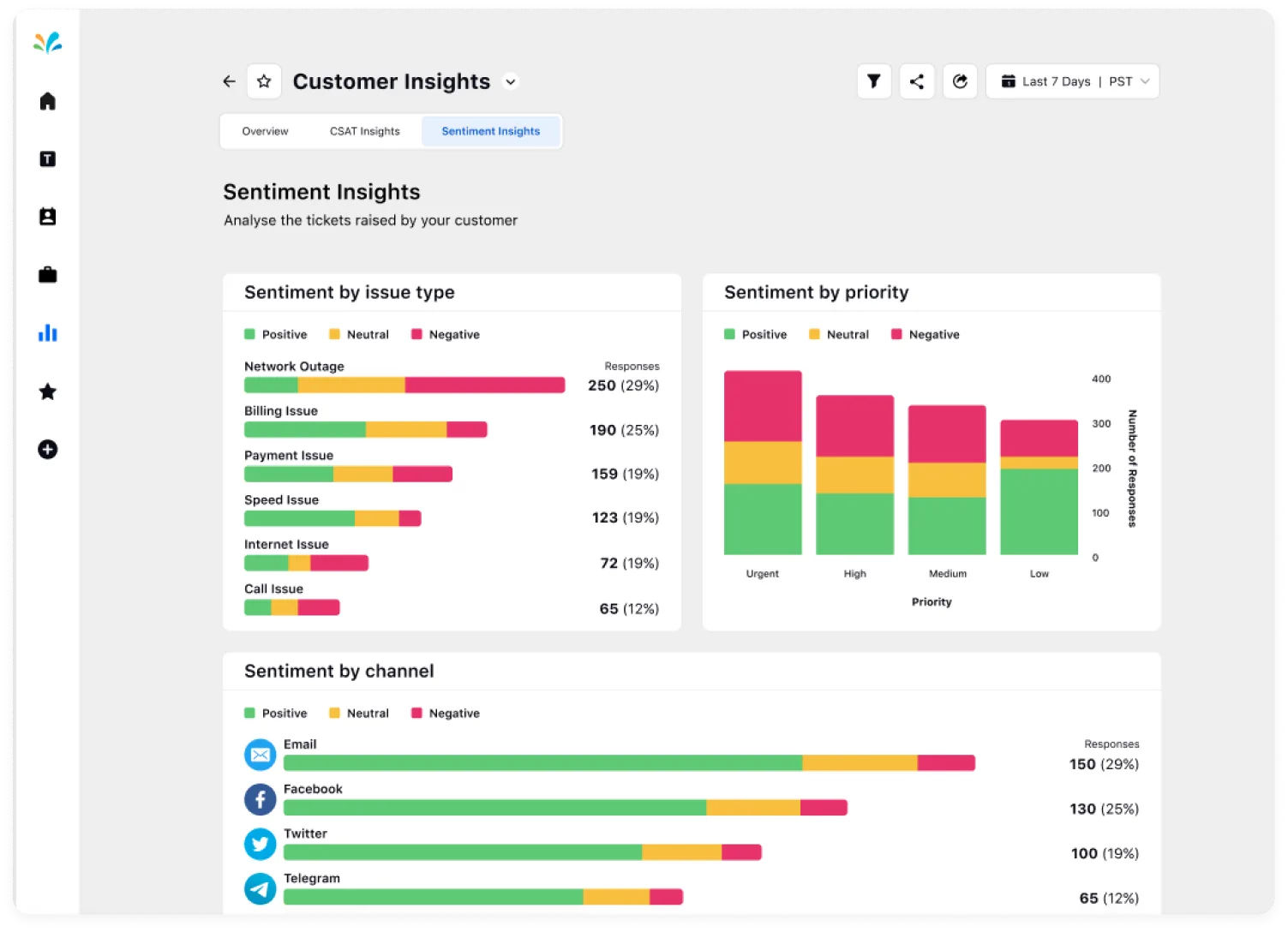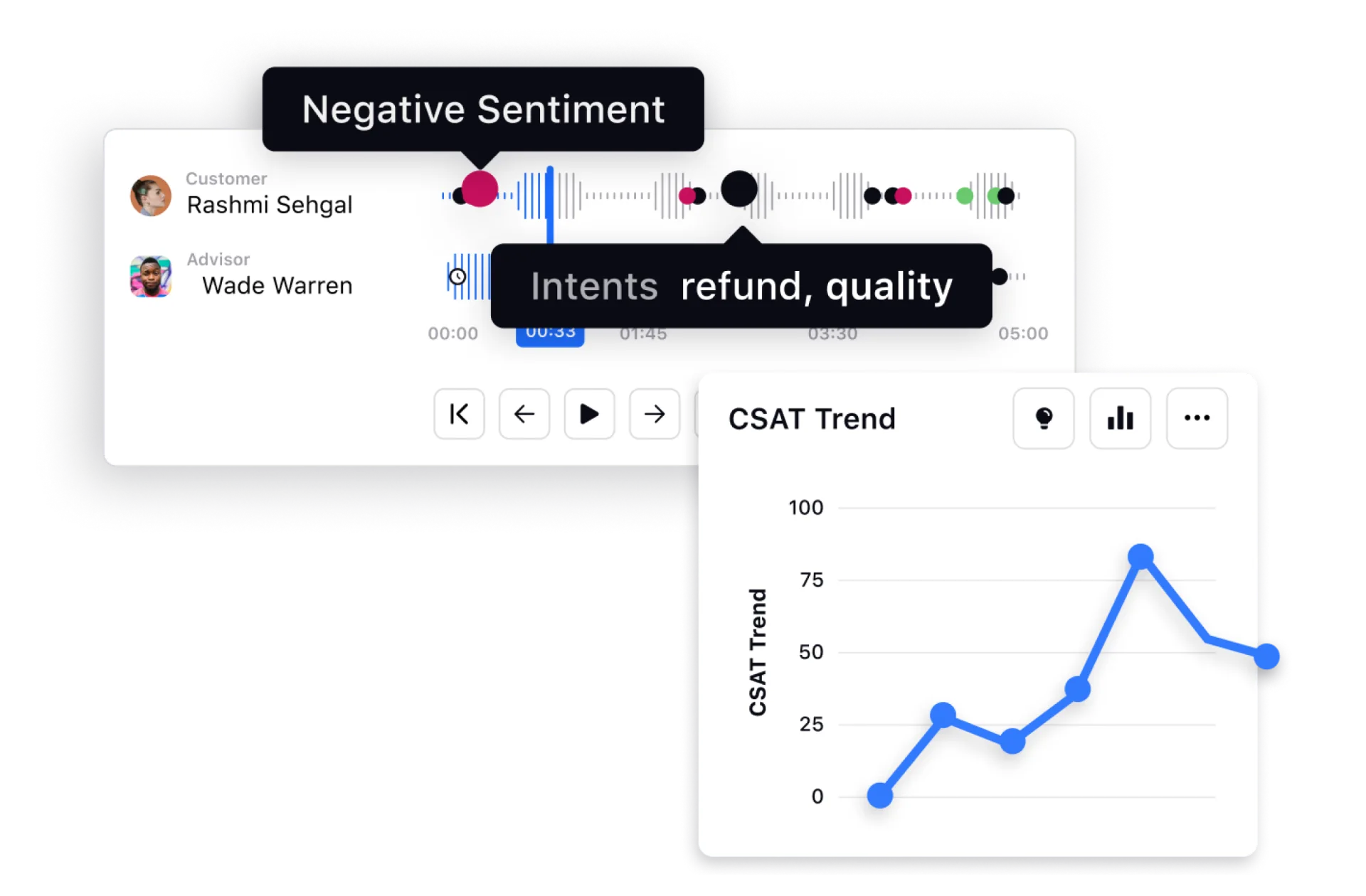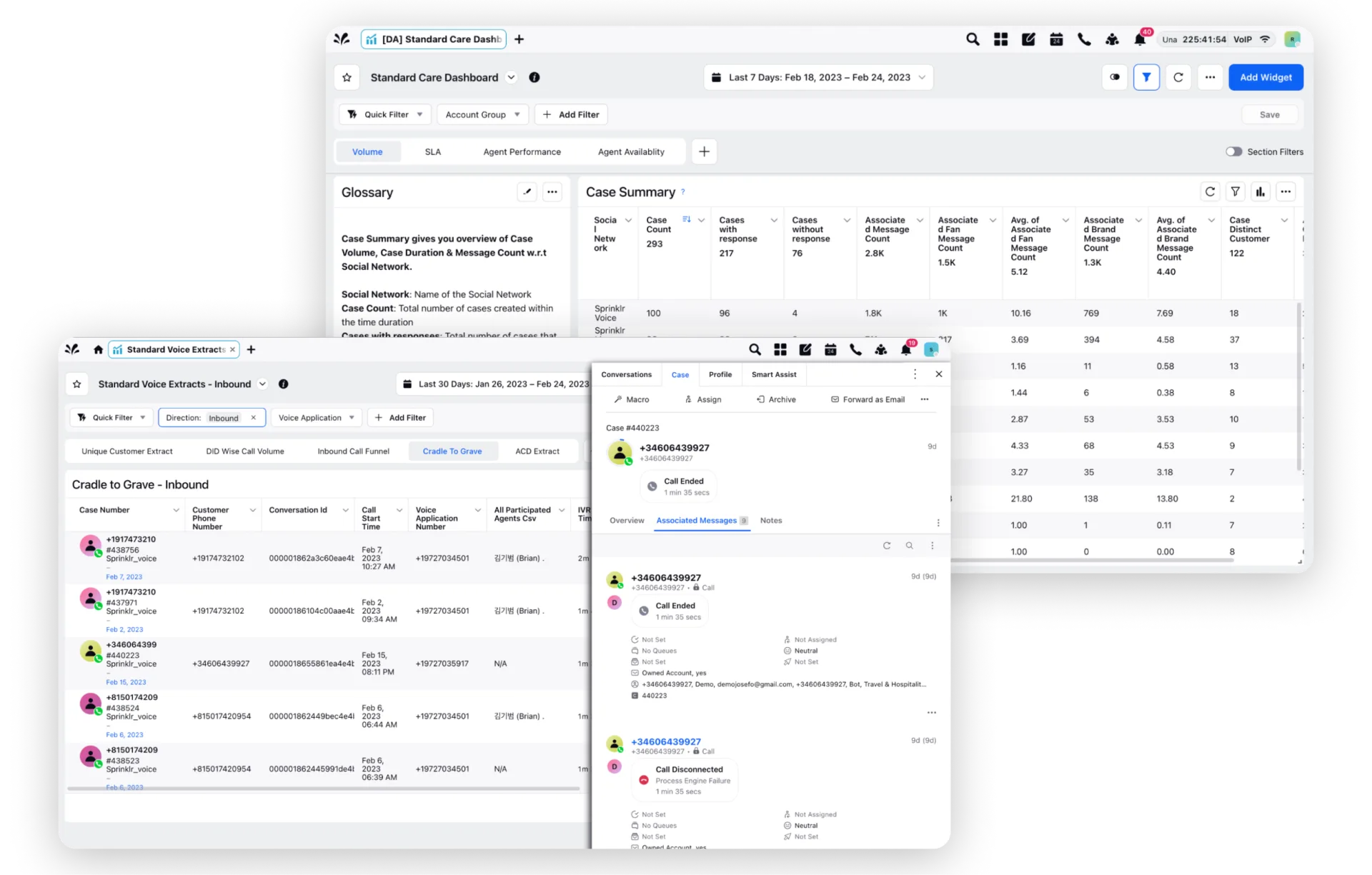Call center sentiment analysis identifies the underlying emotions in customer conversations, whether positive, negative or neutral.
Powered by AI, call center sentiment analysis utilizes natural language processing and machine learning techniques to identify customer tone, intent and sentiment across various customer touchpoints and channels, including voice, chat, online reviews and feedback.
Beyond the constraints of one-by-one call listening, susceptible to human error and surpassing the limited insights of a focus group, which fails to provide a comprehensive understanding of user sentiment, call center sentiment analysis offers a clear picture of how users truly perceive your products, services and brand. This insight contributes significantly to more informed decision-making and strategic planning.
Why is call center sentiment analysis important for your business
With fierce competition and minimal product differentiation, understanding what sets your brand apart and influences customer choices becomes paramount.
Often referred to as “opinion mining”, call center sentiment analysis unveils invaluable insights into user opinions and shifts in buying behavior. This knowledge equips you to adapt proactively, facilitating targeted improvements in products and services and aligning them more precisely with customer expectations and customer service initiatives. Here are the other reasons that make it indispensable.
1. Proactive issue resolution
Since call center sentiment analysis lets you identify the negative sentiments in real time, you can intervene early in the customer journey before customers escalate. It saves your customers time and makes them happy, building customer loyalty.
2. Personalized customer interactions
Delivering distinctive customer service requires the ability to anticipate customer needs. Conversational intelligence provides insights into what customers want, while sentiment analysis goes a step further, enabling the tailoring of the customer experience to resonate individually. This personalized approach fosters customer openness and facilitates smoother upselling and cross-selling opportunities for your agents.
3. Increased operational efficiency
Call center sentiment analysis provides a holistic view of customer sentiment trends. This macro-level understanding enables you to streamline operations, allocate resources more efficiently and identify areas for improvement in their products or services.
For example, imagine a telecommunications company leveraging sentiment analysis to identify a recurring issue causing customer dissatisfaction across various channels. With this insight, the company can streamline its internal processes to address the root cause efficiently, reducing the volume of incoming calls related to the problem. This enhances the overall customer experience and optimizes resource allocation, leading to cost savings and improved operational efficiency.
4. Brand reputation management
By vigilantly monitoring sentiments across various customer service channels, you can gain a comprehensive understanding of your brand's overall perception and optimize brand reputation management.
Capitalizing on positive customer sentiments presents an opportunity to cultivate loyalty programs and transform supporters into brand advocates. Conversely, negative sentiments indicate potential gaps. Addressing these issues in a timely and efficient manner not only resolves immediate concerns but also contributes to building a positive brand perception.
Typical use cases of sentiment analysis in a call center
Now that you have a fair understanding of sentiment analysis and its importance, let’s discuss some classic use cases of sentiment analysis in a call center context.
Call center use cases | How sentiment analysis helps |
Real-time call monitoring | Allows supervisors to identify and address potential issues, ensuring a positive customer experience in real time. |
Automated call routing based on sentiment | Ensures that customers with positive sentiments are directed to agents skilled in upselling, while those with concerns reach support specialists. |
Post-call sentiment feedback | Provides insights for agent performance evaluation and training, leading to continuous improvement in service quality. |
Escalation prediction | Enables proactive intervention to prevent customer issues from escalating, reducing the need for follow-up calls |
Script optimization | Guides script adjustments to ensure they resonate positively with customers, improving communication effectiveness. |
Agent assistance alerts | Alerts agents to potential issues, allowing for immediate action or supervisor intervention to address customer concerns. |
Customer retention analysis | Facilitates proactive retention efforts, such as special offers or personalized outreach, to reduce customer churn rate. |
Customer survey and feedback analysis | Provides valuable insights for product/service improvements and helps prioritize areas for enhancement based on customer feedback |
Call center forecasting based on sentiments | Enables better workforce management, ensuring the availability of sufficient agents during periods of anticipated high call volume related to specific sentiments. |
How does call center sentiment analysis work?
Call center sentiment analysis goes beyond just tracking call center KPIs and delves into the qualitative aspects of customer experience management. Here's how it works:
1. Data collection
There are two ways to gather call center data for sentiment analysis.
Call recording: Most call centers routinely record conversations for call center quality assurance and training initiatives. These recorded interactions serve as the fundamental raw data for subsequent sentiment analysis.
Other channels: Beyond voice interactions, call center sentiment analysis extends its reach to text-based channels, encompassing chat logs and emails. This holistic approach comprehensively understands customer sentiments across diverse customer service channels.
2. Speech-to-text
Automatic speech recognition (ASR) technology plays a pivotal role in sentiment analysis by efficiently transcribing spoken words or audio files, typically derived from call recordings, into plain text. This not only saves considerable time but also enhances productivity across various domains.
💡Pro Tip: While automatic speech recognition technology is a powerful tool, it's essential to acknowledge its limitations. Factors such as different accents, background noise, unclear connectivity and variations in speech can occasionally diminish accuracy. To mitigate these challenges, consider implementing noise reduction techniques, accent adaptation models and periodic system recalibrations to optimize the performance of ASR systems.
3. Tokenization
The transcribed conversations are broken down into smaller units known as tokens, such as words or phrases. Tokenization aids in understanding the context and relationships between different elements of the conversation.
4. Natural language processing (NLP)
NLP enables systems to interpret and understand human language. It involves two critical steps:
Text analysis: In this step, the transcribed text undergoes preprocessing. Preprocessing may include removing irrelevant information, handling abbreviations and correcting errors.
Feature extraction: Here, relevant features are extracted from the text, such as keywords, phrases and linguistic patterns, to gain deeper insights into the conversations.
5. Sentiment lexicon
Some robust sentiment analytics tools leverage sentiment lexicons—a database associating specific words with sentiments. For instance, "angry" conveys a negative sentiment, while "happy" means a positive one.
6. Sentiment analysis
In this pivotal stage, the collected data undergoes processing through the system to determine the overall sentiment of the conversation. Diverse machine learning models, reliant on deep learning and natural language processing techniques, are employed to recognize and classify sentiment. Advanced AI-powered sentiment analysis tools exhibit the capability to discern various types of sentiments within a single call.

7. Sentiment classification
After the analysis, sentiments need to be classified based on insights. This classification occurs in two distinct ways:
Real-time analysis: Whether during a live call or after its completion, the sentiment analysis model classifies transcribed text into predefined sentiment categories like satisfied, dissatisfied, neutral, etc.
Scoring: Some systems go further by providing sentiment scores, indicating the degree of positivity or negativity expressed in the customer’s words.
💡Pro Tip: While automated sentiment analysis models are robust, incorporating a human-in-the-loop validation process can significantly enhance accuracy. Establish a protocol where human evaluators periodically review a sample of sentiment-classified interactions. This iterative feedback loop helps fine-tune the model and ensures that subtle nuances, cultural context and industry-specific sentiments are accurately captured.
8. Integration with call center systems
Sentiment analysis seamlessly integrates with top call center software, offering valuable insights to agents regarding the sentiment of ongoing conversations.
Real-time feedback: Conversations can be segmented, and each segment can be tagged based on sentiment. Supervisors receive these sentiment trends through the dashboard and take corrective actions to enhance customer service.
Automation and routing: Automated systems leverage sentiment analysis results to trigger specific actions, such as escalating a call to a supervisor for assistance. Supervisors can monitor trends regularly for quality management through their dashboards and gain an overview of sentiments across all ongoing calls.
Good to know: Today, you can view your customers’ intents, sentiments and shifts in CSAT scores across the conversation timeline in real time and deliver happier customer experiences. Learn more about Sprinklr quality management software.

9. Data visualization and root cause analysis
Visualization becomes crucial as it sets the context for understanding customer sentiments. Call center managers leverage sentiment analysis reports to assess the root causes of positive and negative sentiments and provide real-time assistance to agents. This helps improve first-call resolutions, avoid unnecessary escalations, and even uncover potential sales opportunities.
Good to know: New-age analytics and reporting software empowers you to track the entire customer journey, dissect pivotal moments in conversations and acquire real-time insights through AI-driven sentiment analysis. Also, its data drill-down capabilities allow you to explore essential specifics, unraveling actionable insights from persona-based, comprehensive, out-of-the-box reports.

10. Continuous improvement
Sentiment analysis is a continual process, not a one-time endeavor. By aggregating data from numerous analyses, patterns and trends emerge, offering valuable insights into areas of excellence that need improvement and those that fall in between.
This analysis provides insights into how scripts, agent attitude and tone in calls, chats and emails impact customer sentiment. For instance, identifying a sentence or phrase triggering a negative emotion allows script improvements or call center agent training adjustments. This iterative process also facilitates the refinement of agent training programs, call center coaching and the enhancement of overall customer service strategies.
Do you know: Sprinklr AI+ helps you score 100% of your daily conversations on 30+ quality and compliance parameters such as opening/closing quality, intro, active listening, empathy and more. You can meticulously track every compliance miss while identifying each agent’s strengths and areas of improvement through detailed agent-wise score breakdowns.

Benefits of call center sentiment analysis
Organizations that overlook sentiment analysis lose significant opportunities to elevate their customer service. Here's a detailed look at what they are precisely missing out on
1. Enhanced customer experience
Deciphering the emotional tones of customer interactions through sentiment analysis empowers call centers to deliver personalized and empathetic customer experiences. Agents can adapt their approach based on customer sentiments, fostering positive engagements.
2. Improved customer satisfaction
Understanding and promptly addressing customer sentiments in real time facilitates immediate issue resolution, increasing customer satisfaction. Satisfied customers are more likely to remain loyal and advocate for the brand.
3. Enhancement in service quality
Using sentiment analysis software solutions enables supervisors to monitor customer-agent interactions in real time, providing immediate oversight and a comprehensive understanding of ongoing interactions.
Furthermore, sentiment analysis equips agents with insights into customer sentiment throughout the call, enabling them to tailor their responses accordingly. Real-time service quality insights play a pivotal role in elevating the overall standard of customer service.
As agents grasp the nuances of conversations and the sentiments behind them, they can infuse customer empathy, personalization and persuasion into their interactions. This, in turn, leads to quicker resolutions and a reduction in average handle time (AHT) without compromising customer satisfaction.
Here’s how AI helps: New-age conversational analytics software analyzes live data to spot problems in need of attention — such as missed SLAs by a team or region or interactions with low predicted CSAT — and generates automatic alerts for supervisors.

4. Tailored customer support
Agents armed with insights into customer sentiments can precisely tailor their support strategies to align with the caller's emotional state. This personalized approach leaves a lasting impression in customers' minds and becomes a significant competitive advantage as your business grows.
Must Read: Customer Support vs. Customer Service: What is the Difference?
5. Reduced escalations
The ability to promptly identify and address concerns through call center sentiment analysis significantly reduces escalations. This, in turn, results in higher customer satisfaction and boosts agent morale.
Deep Dive: Escalation Management: How to Manage it Effectively
6. Agent performance enhancement
Sentiment analysis is a valuable tool for evaluating call center agent performance metrics, offering a thorough assessment of customer interactions that would be challenging to achieve manually. This feedback loop highlights glaring gaps and facilitates the implementation of targeted training programs, ultimately enhancing call center skills and overall service quality.
7. Market intelligence
Gauging public reactions and sentiments in real-time allows you to adjust marketing strategies dynamically, optimizing the effectiveness of their campaigns.
Targeted engagement: Sentiment analysis facilitates audience targeting, enabling businesses to craft marketing messages tailored to specific customer segments.
Competitor analysis: Analyzing sentiments related to competitors provides valuable market intelligence. Insights into competitors' strengths and weaknesses empower informed marketing decisions, contributing to more competitive positioning.
Benchmarking: Comparative analysis of sentiment trends with competitors helps benchmark performance. Understanding where differentiation is possible in the market allows for strategic improvements in marketing efforts. Here’s how to get started with benchmarking.
8. Improved quality management
Call center sentiment analysis is a rich source of insights into how agents navigate various customer interactions and call situations. Focusing on calls marked by negative sentiments enables a deeper understanding of the triggers behind such negativity.
Identifying areas for improvement becomes more efficient, allowing for the creation of tailored training programs to address these limitations promptly.
Acing call center sentiment analysis with Sprinklr Service
Organizations typically encounter three main hurdles when seeking to comprehend the authentic voice of customer.
Firstly, they employ haphazard, manual call-sampling methods, capturing a meager fraction of all interactions and generating unrepresentative raw data sets.
Secondly, using legacy processing systems for converting speech to text significantly constrains extracting valuable information due to subpar accuracy.
Lastly, despite accurately transcribing conversations, efforts to translate them into meaningful insights often fall short.
Here is where Sprinklr Service can turn things around for you. Built on the world's only Unified Customer Experience Management Platform (Unified-CXM), Sprinklr Service provides:
100% tracking of conversations and real-time insight into your brand's health by showing current sentiment towards your brand or topic.
Accurate tracking of the sentiments of significant influencers of your brand.
Creating and monitoring campaigns by analyzing the sentiments attached to them.
Keeping track of major influencer accounts.
Enabling you to use Smart Alerts when anything related to your brand is met with negative sentiments.
Schedule a demo with our experts today to experience the platform.
Frequently Asked Questions
related products
Thank you for contacting us.
A Sprinklr representative will be in touch with you shortly.
Contact us today, and we'll create a customized proposal that addresses your unique business needs.
Request a Demo
Welcome Back,
No need to fill out any forms — you're all set.


